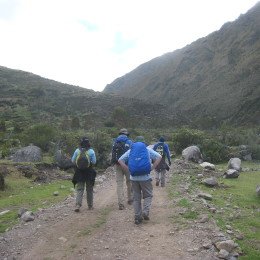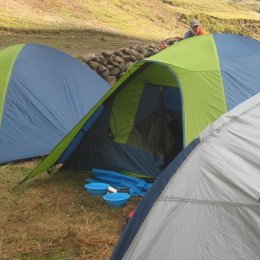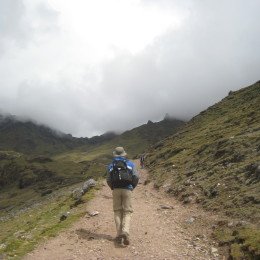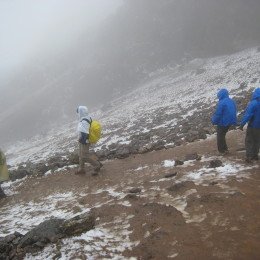Hiking Up a Big Mountain
Like To Share An Article from My Travel Website on Hiking in the Mountains
Original Post Is Here. http://www.excitingworldtravels.com/hiking-and-trekking-high-up/
Hiking Up a Big Mountain
You love hiking, but you have yet to attempt high altitude. Get ready to take on the “holy grail trails” of your hiking dreams.
IMG_0381 Hiking and Trekking High Up
I will consider “high altitude” as any height that is likely to have an effect on the average hiker. Height is measured from sea level. Atmospheric pressure decreases as altitude increases. Any height above 4,900 feet can create symptoms of health problems in some people. I live in a town a little over 6,000 feet above sea level. For many of us, returning from a vacation requires a little adjustment. We feel unusually tired. We might get winded when walking. Ideally, we take it easy, reduce our activity for a while, and are fine. Some tourists who visit my hometown don’t fare as well. I met one woman (an asthmatic) who was bedridden within a few days. Fortunately, the place does not affect most people (not even most asthmatics) that way.

High altitude health problems include “altitude sickness” can look like the flu with headache, fatigue and nausea. It presents as a risk at about 8,000 feet although, as noted, it can occur earlier. Symptoms might not present themselves for several hours after arriving. Generally, rest will be sufficient, but sometimes the illness progresses to pulmonary edema, where the lungs fill with fluid and breathing is significantly inhibited even at rest or to cerebral edema where the headache worsens and does not respond to usual over-the-counter medication. The affected person may lose his or her balance and even pass out. Both pulmonary and cerebral edemas are serious conditions and require medical attention. Other symptoms of pulmonary edema may include a cough or fever. Cerebral edema may cause retinal bleeding manifested possibly only by blurry vision. Below 26,000 feet, those who do not suffer seriously from these illnesses will likely adapt. Too long above 26,000 feet, in “the Death Zone,” you probably won’t survive. The summit of Mount Everest is 29, 035 feet.IMG_0411 Hiking and Trekking High Up

A few years ago, Lincoln Hall, with a quarter century of experience as a mountain climber, attempted Mount Everest in the company of some friends and Sherpa guides. Not far from the summit, Hall became extremely tired and told the guide he needed a nap. He had cerebral edema, but he didn’t know it. Given the brain dysfunction, he was increasingly uncooperative. Some Sherpa guides tried to help but were told to leave him on the mountain, where, limp and nonresponsive, he appeared dead to those who checked him. Another climber, nearby, had died not long before. Climbers, as we all know, regularly fail to make the summit, and not an insignificant number die on Everest. Cathy Free, in her Reader’s Digest account of this tale, quotes a hiker, “There are times when you literally have to step over somebody’s body to get to the top.” Hall eventually woke up, and, with the help of other mountaineers, did survive.

Most hikers are not going to attempt Mount Everest (or the other thirteen mountains that are this high), but if you do, you should be aware that a study by a Massachusetts General Hospital doctor, Paul Firth, concluded most mountaineers at that level died from HACE (high-altitude cerebral edema). Most people are going to hike at lower elevations. According to the Hiking Dude, “common” high altitude in the U.S. ranges from 8,000 to 13,000 feet. Let’s start with that range. The Hiking Dude has recommendations for dealing with less oxygen. They include hiking at a slower but steady pace, taking deeper breaths and stopping to rest. When you take a step, take a breath. Remember also to maintain good hydration.
IMG_0431 Hiking and Trekking High Up
Hiking at high altitudes means that you will confront colder air so you need to dress in layers for warmth, and you will have increased sun exposure so remember the sunscreen and sunglasses. According to Dr. Darrell Rigel who studied sunburn risk at high elevations, “(T)he direct UV-B in Vail (Colorado) were the same as those in Orlando (Florida).” According to the same article, the average person would need only six minutes to burn at 11,000 feet. Obviously, high altitude hiking requires the same kind of sunburn protection as does the beach. Wear a hat. You don’t need to be told to wear a good pair of hiking boots, do you?

You wouldn’t go out and run a marathon without a little preparation. Or would you? Well, one major difference is that you won’t have a crowd watching or ambulances within a few blocks if you’re hiking up in the mountains, so work your way up. Begin with lower elevations. As you get accustomed to the effect of higher altitudes on you (since effects vary among even healthy individuals), you can increase the climb. If, like most people, you work during the week, don’t let too many weekends pass in between climbs. You want to stay in shape as well as keep your lungs familiar with high altitude’s decreasing oxygen and demands on the body. In short, acclimate! You can also train at lower elevations using other aerobic exercise such as biking, running and stair climbing, but get that heart rate up. The idea is to get the body accustomed to making better use of available oxygen. When you do go to the higher elevation, give yourself a couple of days of rest before you start hiking.IMG_0451 Hiking and Trekking High Up
How many hikers do you suppose are lost in a given year? Before you go, tell someone where you are going and when you plan to return. Do this even if you are not planning on hiking alone. A companion could be injured. Mountains can be fickle friends. Weather can change in an instant. Check the forecast before you leave, but don’t count on it. You must be prepared. Serious problems can occur even at low elevations. Always prepare to stay overnight. You need a compass, a map and matches. You can’t count on your cell phone to reach rescue. Start back as soon as you think you might be in trouble.
Thanks for Reading My Amazing Article On Hiking
How To Reach Exciting World Cryptos
Connect with Exciting World Cryptos on Social Media!
Check Out My Website: www.newcodelogic,com
Subscribe to our youtube page: https://www.youtube.com/user/koss78b2
Follow us on Twitter @ExcitingWorld32
We’re on Steemit too : https://steemit.com/@worldtraveller32
Check Out and Offer a Pledge on BitBacker: Exciting World Cryptos
Donate to our Patreon: Exciting World Cryptos
Contact With Me At Email: [email protected]
Big Thanks To the Community of @SteemNurse For Making This Video Possible
Also Special Mention to @NathanMars @KawaiiCrush @HeadNurse
Many More Thanks to @linkseven77 @prettynicevideo @Blind-Spot
Come to SteemNurse - a Good Community Where Everyone Helps Each Other
If you are interested in free Steem Support with Steem Nurse
Please contact kawaiicrush#9789 on Discord!
Thanks for watching; Please Like, Subscribe, and Share if you found this useful!
thanks to share your travel and hiking journey. i also read your full blog step by step.
I have never seen the mountain in reality